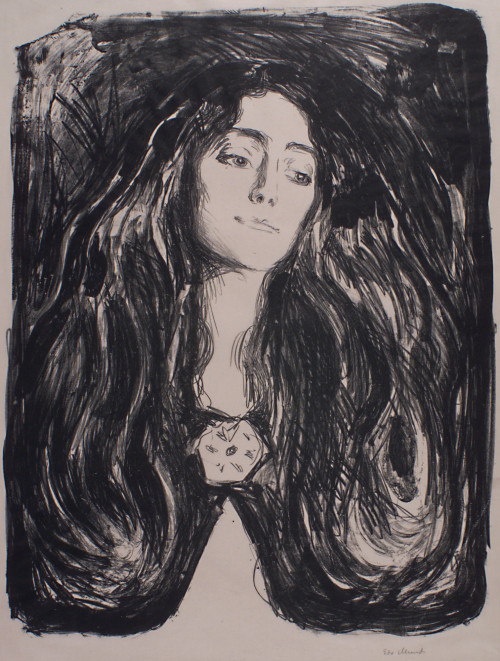Lithography is a complex, multi-step process that relies on chemical reactions to create a transfera
Lithography is a complex, multi-step process that relies on chemical reactions to create a transferable image. The benefit of this process is that the printed image will exactly match what the artist drew onto the limestone with and oil-based crayon—especially noticeable in Munch’s painterly strokes. Once the drawing is complete, the surface is covered in powdered rosin and talc, and then treated with liquid gum arabic or a mild acid. This ensures that the exposed areas of the stone will absorb water while the the drawn areas remain oily. A solvent called lithotine is used to wash away the crayon itself. The entire surface is treated with asphaltum and then water. Finally, an oil-based ink is applied to the surface which only adheres to the oily areas of the original drawing as the water that soaked into the blank areas repels it. Paper can then be pressed onto the surface creating the print. Like with most print-making techniques, multiple colors—as we see in Nolde’s work—required multiple stones.See lithographs and other #BKMWorksonPaper before it closes this Sunday.Posted by Elizabeth TreptowEdvard Munch (Norwegian, 1863-1944). Eva Mudocci, 1903. Lithograph on wove paper. Brooklyn Museum, Charles Stewart Smith Memorial Fund, 38.253. © artist or artist’s estate ⇨ Emil Nolde (German, 1867-1956). South Sea Islander (Südsee-Insulaner II), 1915. Color lithograph on wove paper. Brooklyn Museum, A. Augustus Healy Fund, 53.254.3 -- source link
Tumblr Blog : brooklynmuseum.tumblr.com
#bkmworksonpaper#bkmeuropeanart#edvard munch#eva mudocci#lithograph#emil nolde#brooklyn museum#european art#printmaking

